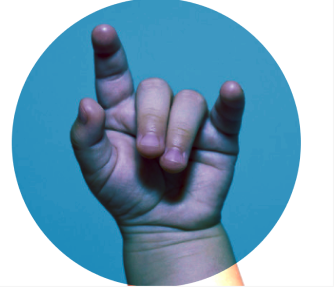For many parents, the arrival of a new baby brings a deep feeling of excitement and joy—and also, perhaps some apprehension. After all, being responsible for another little person’s wellbeing is no small undertaking! From the nursery to the playground, a baby’s world can be an overwhelming place filled with lots of stimulation, especially with hearing loss. But what if they could take in all that was going on around them by just using their hands? Sign Language is not as hard to learn as you think – not for babies!
Now, you might be thinking sign language has to be harder for babies to learn than adults right? Actually, because babies’ brains are not fully developed, they can absorb signing information much faster. As their language and reasoning skills mature, their retention of hand signs will solidify at an early age. Lucky little ones! Research shows that babies start paying attention to signs at four months and actually reciprocate and use these signs by eight to ten months. Don’t we all wish we could learn that fast!!
It’s really important that we expose our children, and we raise our children in environments that are rich in detail and rich in experiences, because they are learning about everything that’s around them. – CAMERON ELLIS, PHD
Let’s break down some great tips to keep in mind when teaching infants sign language:
Pair actions, words, and objects with every sign

To start, pair a word with a hand sign in order to give the word meaning. This is especially helpful for babies with slight hearing loss so they can become accustomed to the sound of the word and its sign. For those that have more extreme hearing loss, apply more focus to your actions. For example, when they want to eat or drink, couple the motion with its corresponding hand sign. Giving objects like blankets or toys their own corresponding signs as well makes learning sign language more interactive.
Sign Consistently
Repetition is key!! Make sure your signing is consistent and frequent as well as your baby’s. You are the teacher and the one they look up to the most! Your baby is admiring and absorbing your every move so the more you sign, the faster they will learn and imitate you.
Use Your Surroundings
We all know babies have short attention spans, but we also know how much they like new things and playing with them! Use their toys, their favorite stuffed animals, and everything around you when teaching them new signs. Bring these objects close to their face and sign while you have their attention. Then, give it to them to play with!
Follow the Leader
The baby is the boss…sort of. If your baby starts to create their own signs, let them! Don’t panic or become frustrated. Sometimes you can work on correcting important signs like “hungry”, “thirsty”, or “sleepy,” however, those that are less important can be taught with leniency. If your baby changes or modifies some signs, let them, it makes them more meaningful to them as they develop their motor skills.

Reward Them!!
Acknowledge your baby’s success and progress. Positive reinforcement works like a charm!
Know When to Sign Off
Just like every other language and lesson, sign language can become tiring and repetitive. Give them some time to recuperate and be a kid. When they start getting frustrated, use signs of overload and stop the lesson. The idea is to reduce stress and make learning fun, not tedious.
So, there you have it! A few reasons why learning sign language is so important for infants and some tips on how to make it fun. Now get out there and start signing with your little ones! Don’t be afraid to start early, the sooner they learn the better. If you want more information on teaching sign language or other parenting hacks, be sure to check out our website for more great articles.
-RHIposthttps://rescuehearing.com/sign-language-and-hearing-loss/

